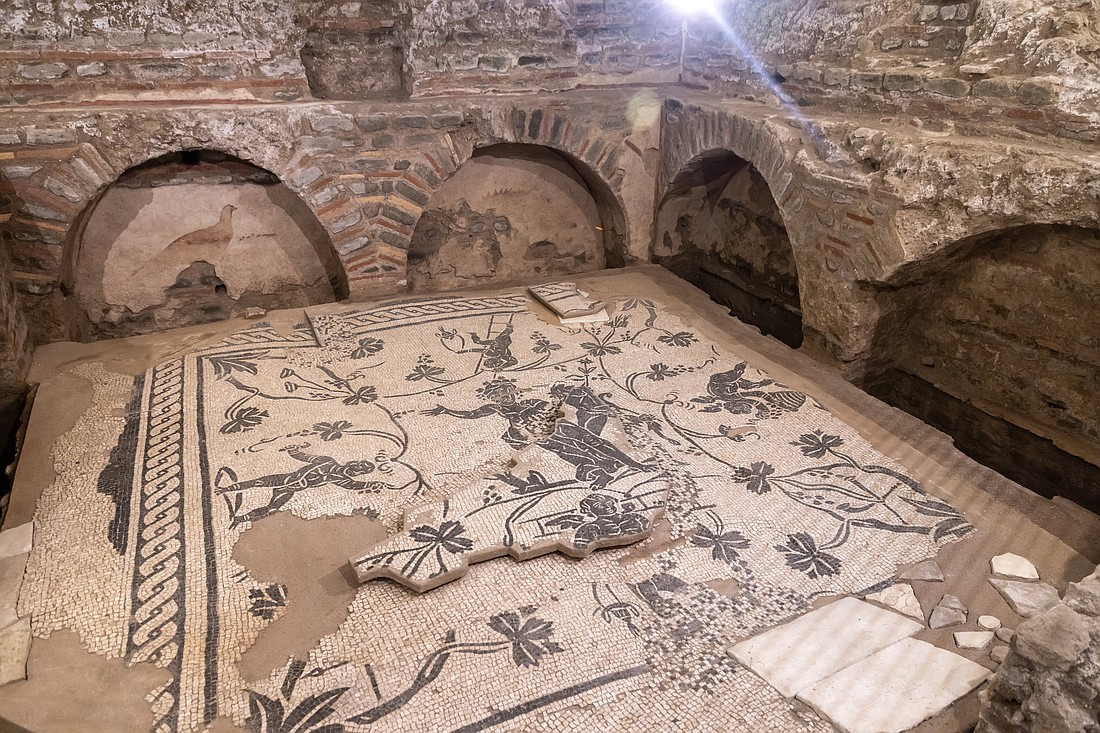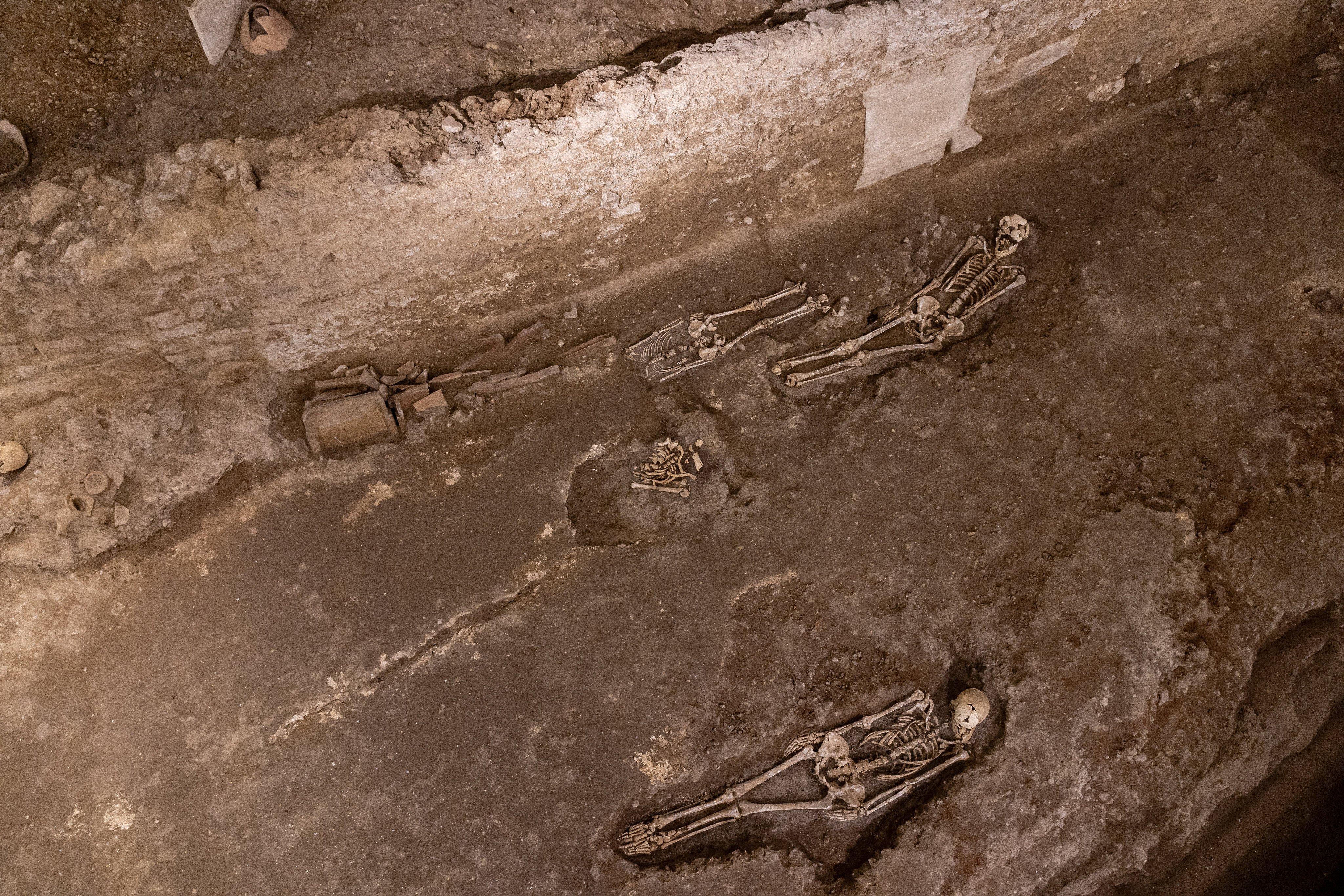Honoring the dead: Vatican Museums expand access to necropolis
November 15, 2023 at 2:06 p.m.

VATICAN CITY CNS – In the month Catholics traditionally honor the dead, the Vatican Museums opened a new entrance to an ancient necropolis where carved marble sarcophagi sit near open graves filled with bones.
PHOTO GALLERY- Via Triumphalis Necropolis
In the Via Triumphalis Necropolis, some of the tombs and cremation urns have the person's name on them. Others also include the person's age or occupation.
But when the only physical evidence of the person's life and existence are skeletal remains, examining them and returning them to their final resting place is the best way to honor them, said Giandomenico Spinola, an archaeologist and deputy artistic-scientific director of the museums.
The study of the bones and their wear and tear "gives us an idea of what their occupation was, what kind of life they led, what their nutrition was like," he said. "In my opinion, it is a way to respect them and give them a voice."
Vatican construction in the 1950s indicated there were graves in the area. But the necropolis, which is not connected to the ancient Christian burial ground under St. Peter's Basilica, really came to light in 2003 when the Vatican was digging for a new multilevel parking garage for employees.
With funding from the Canadian chapter of the Patrons of the Arts in the Vatican Museums, it was opened to the public in 2013. But access was limited to groups taking a package tour of the museums.
Barbara Jatta, director of the museums, told reporters Nov. 14 that increased interest in the necropolis along with an expected increase in visitors for the Holy Year 2025 led to the decision to allow visitors direct access to the burial grounds on Friday afternoons and all day on Saturdays. The new entrance is though the parking garage.
The burial ground was used from the first century B.C. to the fourth century A.D. It has several layers because of a history of mudslides, which preserved many of the graves and tombs and their decorations, including frescoes and mosaic floors as well as inscriptions carved in marble.
Perhaps the most touching decoration is a marble sculpture of a small boy's head with the inscription underneath that says, "Vixit Anni IIII Menses IIII Dies X," Latin for "He lived four years, four months and 10 days."
Jatta told reporters the excavation is "unique" because "it tells the story of burials but also of lives," especially of people in Rome's lower and middle classes, which usually were not preserved.
Spinola, who was head of the Vatican Museums' archaeology department when the site was uncovered during work on the parking garage, reminded reporters that the study and preservation of the graves and tombs almost didn't happen. In fact, the Vatican department responsible for building the garage was accused of trying to hide the discovery in order to get the parking structure finished on time. Journalists helped create a public outcry, and Spinola and his team were brought in.
The excavations and preservation work, which are ongoing, "have helped us give a voice to people who were never mentioned" by name in history books: slaves, artisans and laborers in the Roman Empire, he said.
The burial ground and its decorations are filled with references to the dead's family, family traditions, "superstitions, fears and hopes. There is all of this and nothing, absolutely nothing that refers to the official religion" of the pagan empire or to Christianity since the burials there stopped while Christians still were being persecuted.
Asked about the graves where bones are lying in the dirt, Spinola said that after 1,700 years or more all traces of organic material have disappeared. Depending on their family's means, he said, the bodies were probably buried in hollowed-out logs or wrapped in a bundle of branches or straw.
Each of the hundreds of tombs, graves and cremation urns in the necropolis, he said, tells the story of a life.
Claudia Valeri, director of the museum's Department of Greek and Roman Antiquities, said that even while the necropolis is open to the public, the archaeological excavation and study continues with funding from the Washington chapter of the Patrons of the Arts in the Vatican Museums.
And there is plenty of work for future researchers as well, she said. "There are hundreds of burials here and each one would be worthy of a micro-excavation."
Related Stories
Friday, July 26, 2024
E-Editions
Events
VATICAN CITY CNS – In the month Catholics traditionally honor the dead, the Vatican Museums opened a new entrance to an ancient necropolis where carved marble sarcophagi sit near open graves filled with bones.
PHOTO GALLERY- Via Triumphalis Necropolis
In the Via Triumphalis Necropolis, some of the tombs and cremation urns have the person's name on them. Others also include the person's age or occupation.
But when the only physical evidence of the person's life and existence are skeletal remains, examining them and returning them to their final resting place is the best way to honor them, said Giandomenico Spinola, an archaeologist and deputy artistic-scientific director of the museums.
The study of the bones and their wear and tear "gives us an idea of what their occupation was, what kind of life they led, what their nutrition was like," he said. "In my opinion, it is a way to respect them and give them a voice."
Vatican construction in the 1950s indicated there were graves in the area. But the necropolis, which is not connected to the ancient Christian burial ground under St. Peter's Basilica, really came to light in 2003 when the Vatican was digging for a new multilevel parking garage for employees.
With funding from the Canadian chapter of the Patrons of the Arts in the Vatican Museums, it was opened to the public in 2013. But access was limited to groups taking a package tour of the museums.
Barbara Jatta, director of the museums, told reporters Nov. 14 that increased interest in the necropolis along with an expected increase in visitors for the Holy Year 2025 led to the decision to allow visitors direct access to the burial grounds on Friday afternoons and all day on Saturdays. The new entrance is though the parking garage.
The burial ground was used from the first century B.C. to the fourth century A.D. It has several layers because of a history of mudslides, which preserved many of the graves and tombs and their decorations, including frescoes and mosaic floors as well as inscriptions carved in marble.
Perhaps the most touching decoration is a marble sculpture of a small boy's head with the inscription underneath that says, "Vixit Anni IIII Menses IIII Dies X," Latin for "He lived four years, four months and 10 days."
Jatta told reporters the excavation is "unique" because "it tells the story of burials but also of lives," especially of people in Rome's lower and middle classes, which usually were not preserved.
Spinola, who was head of the Vatican Museums' archaeology department when the site was uncovered during work on the parking garage, reminded reporters that the study and preservation of the graves and tombs almost didn't happen. In fact, the Vatican department responsible for building the garage was accused of trying to hide the discovery in order to get the parking structure finished on time. Journalists helped create a public outcry, and Spinola and his team were brought in.
The excavations and preservation work, which are ongoing, "have helped us give a voice to people who were never mentioned" by name in history books: slaves, artisans and laborers in the Roman Empire, he said.
The burial ground and its decorations are filled with references to the dead's family, family traditions, "superstitions, fears and hopes. There is all of this and nothing, absolutely nothing that refers to the official religion" of the pagan empire or to Christianity since the burials there stopped while Christians still were being persecuted.
Asked about the graves where bones are lying in the dirt, Spinola said that after 1,700 years or more all traces of organic material have disappeared. Depending on their family's means, he said, the bodies were probably buried in hollowed-out logs or wrapped in a bundle of branches or straw.
Each of the hundreds of tombs, graves and cremation urns in the necropolis, he said, tells the story of a life.
Claudia Valeri, director of the museum's Department of Greek and Roman Antiquities, said that even while the necropolis is open to the public, the archaeological excavation and study continues with funding from the Washington chapter of the Patrons of the Arts in the Vatican Museums.
And there is plenty of work for future researchers as well, she said. "There are hundreds of burials here and each one would be worthy of a micro-excavation."











